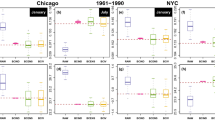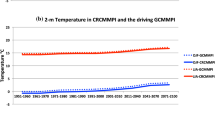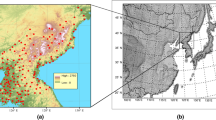Abstract
Bias correction methods have now emerged as the most commonly used approach when applying climate model outputs to impact studies. However, comparatively much fewer studies have looked at the limitations of bias correction caused by the very nature of the climate system. Two main sources of errors can affect the efficiency of bias correction over a future period: climate sensitivity and internal variability of the climate system. The former is related to differences in the forcing response between a climate model and the real climate system, whereas the latter results from the chaotic nature of the climate system. Using a “pseudo-reality” approach, this study investigates the contribution of these two sources of error to remaining biases of climate model after bias correction for future periods. The pseudo-reality approach uses one climate model as a reference dataset to correct other climate models. Results indicate that bias correction is beneficial over the reference period and in near future periods. However, large biases remain in future periods. The difference in climate sensitivities is the main contributor to the remaining biases in corrected data. Internal variability affects the near and far future similarly and may dominate in the near future, especially for precipitation. The impact of differences in climate sensitivity between the reference dataset and climate model data cannot be eliminated, while the impact of internal variability can be lessened by using a reference period for as long as possible to filter out low-frequency modes of variability.










Similar content being viewed by others
References
Ahmed KF, Wang G, Silander J, Wilson AM, Allen JM, Horton R, Anyah R (2013) Statistical downscaling and bias correction of climate model outputs for climate change impact assessment in the U.S. northeast. Glob Planet Chang 100:320–332
Bellprat O, Massonnet F, Siegert S, Prodhomme C, Macias-Gómez D, Guemas V, Doblas-Reyes F (2017) Uncertainty propagation in observational references to climate model scales. Remote Sens Environ 203:101–108
Cannon AJ (2018) Multivariate quantile mapping bias correction: an n-dimensional probability density function transform for climate model simulations of multiple variables. Clim Dyn 50(1–2):31–49
Caya D, Laprise R (1999) A semi-implicit semi-lagrangian regional climate model: the Canadian RCM. Mon Weather Rev 127:341–362
Chen J, Brissette F (2017) Hydrological modeling using proxies for gauged precipitation and temperature. Hydrol Proces 31(22):3881–3897
Chen J, Brissette FP, Leconte R (2011) Uncertainty of downscaling method in quantifying the impact of climate change on hydrology. J Hydrol 401:190–202
Chen J, Brissette FP, Leconte R (2012) Coupling statistical and dynamical methods for spatial downscaling of precipitation. Clim Chang 114:509–526
Chen J, Brissette FP, Chaumont D, Braun M (2013a) Performance and uncertainty evaluation of empirical downscaling methods in quantifying the climate change impacts on hydrology over two North American river basins. J Hydrol 479(4):200–214
Chen J, Brissette FP, Chaumont D, Braun M (2013b) Finding appropriate bias correction methods in downscaling precipitation for hydrologic impact studies over North America. Water Resour Res 49:4187–4205
Chen J, Brissette FP, Lucas-Picher P (2015) Assessing the limits of bias-correcting climate model outputs for climate change impact studies. J Geophys Res Atmos 120(3):1123–1136
Chen J, St-Denis BG, Brissette FP, Lucas-Picher P (2016) Using natural variability as a baseline to evaluate the performance of bias correction methods in hydrological climate change impact studies. J Hydrometeorol 17(8):2155–2174
Chen J, Li C, Brissette FP, Chen H, Wang M, Essou GRC (2018) Impacts of correcting the inter-variable correlation of climate model outputs on hydrological modeling. J Hydrol 560:326–341
Chen J, Brissette FP, Zhang XJ, Chen H, Guo SL, Zhao Y (2019) Bias correcting climate model multi-member ensembles to assess climate change impacts on hydrology. Clim Chang 153(3):361–377
Christensen JH, Boberg F, Christensen OB, Lucas-Picher P (2008) On the need for bias correction of regional climate change projections of temperature and precipitation. Geophys Res Lett 35(20):L20709. https://doi.org/10.1029/2008GL035694
Eisner S, Voss F, Kynast E (2013) Statistical bias correction of global climate projections – consequences for large scale modeling of flood flows. Adv Geosci 31:75–82
Guo Q, Chen J, Zhang XJ, Shen M, Chen H, Guo S (2019) A new two-stage multivariate quantile mapping method for bias correcting climate model outputs. Clim Dyn. https://doi.org/10.1007/s00382-019-04729-w
Gutiérrez JM, Maraun D, Widmann M et al (2019) An intercomparison of a large ensemble of statistical downscaling methods over Europe: results from the VALUE perfect predictor cross-validation experiment. Int J Climatol 39:3750–3785
Hnilica J, Hanel M, Puš V (2017) Multisite bias correction of precipitation data from regional climate models. Int J Climatol 37(6):2934–2946
Hui Y, Chen J, Xu C-Y, Xiong L, Chen H (2019) Bias nonstationarity of global climate model outputs: the role of internal climate variability and climate model sensitivity. Int J Climatol 39(4):2278–2294
Ines AVM, Hansen JW (2006) Bias correction of daily GCM rainfall for crop simulation studies, Agric. For Meteorol 138(1–4):44–53
Johnson F, Sharma A (2012) A nesting model for bias correction of variability at multiple time scales in general circulation model precipitation simulations. Water Resour Res 48:W01504. https://doi.org/10.1029/2011WR010464
Jones RG, Murphy JM, Noguer M (1995) Simulation of climate change over Europe using a nested regional-climate model. I: assessment of control climate, including sensitivity to location of lateral boundaries. Q J R Meteorol Soc 121:1413–1449
Maraun D (2012) Nonstationarities of regional climate model biases in European seasonal mean temperature and precipitation sums. Geophys Res Lett 39:L06706. https://doi.org/10.1029/2012GL051210
Maraun D, Wetterhall F, Ireson AM et al (2010) Precipitation downscaling under climate change: recent developments to bridge the gap between dynamical models and the end user. Rev Geophys 48(3):RG3003
Maraun D, Huth R, Gutiérrez JM et al (2017a) The VALUE perfect predictor experiment: evaluation of temporal variability. Int J Climatol. https://doi.org/10.1002/joc.5222
Maraun D, Shepherd TG, Widmann M et al (2017b) Towards process-informed bias correction of climate change simulations. Nat Clim Chang 7(11):764–773
Maraun D, Widmann M, Gutierrez JM (2019) Statistical downscaling skill under present climate conditions: a synthesis of the VALUE perfect predictor experiment. Int J Climatol 39:3692–3703
Massonnet F, Bellprat O, Guemas V, Doblas-Reyes JF (2016) Using climate models to estimate the quality of global observational data sets. Science 354(6311):452–455
Mpelasoka FS, Chiew FHS (2009) Influence of rainfall scenario construction methods on runoff projections. J Hydrometeorol 10:1168–1183
Muerth MJ, Gauvin St-Denis B, Ricard S, Velázquez JA, Schmid J, Minville M, Caya D, Chaumont D, Ludwig R, Turcotte R (2013) On the need for bias correction in regional climate scenarios to assess climate change impacts on river runoff. Hydrol Earth Syst Sci 17:1189–120
Nahar J, Johnson F, Sharma A (2017) Assessing the extent of non-stationary biases in GCMs. J Hydrol 549:148–162
Piani C, Haerter O, Corpola E (2010) Statistical bias correction for daily precipitation in regional climate models over Europe. Theor Appl Climatol 99:187–192
Pierce DW, Cayan DR, Maurer EP, Abatzoglou JT, Hegewisch KC (2015) Improved bias correction techniques for hydrological simulations of climate change. J Hydrometeorol 16:2421–2442
Rajczak J, Kotlarski S, Schär C (2016) Does quantile mapping of simulated precipitation correct for biases in transition probabilities and spell lengths? J Clim 29:1605–1615
Rhynsburger D (1973) Analytic delineation of thiessen polygons. Geogr Anal 5:133–144
Schmidli J, Frei C, Vidale PL (2006) Downscaling from GCM precipitation: a benchmark for dynamical and statistical downscaling methods. Int J Climatol 26:679–689
Sharma D, Das Gupta A, Babel MS (2007) Spatial disaggregation of bias-corrected GCM precipitation for improved hydrologic simulation: Ping river basin, Thailand. Hydrol Earth Syst Sci 11(4):1373–1390
Switanek MB, Troch P, Castro C et al (2017) Scaled distribution mapping: a bias correction method that preserves raw climate model projected changes. Hydrol Earth Syst Sci 21:264–2666
Taylor KE, Stouffer RJ, Meehl GA (2012) An overview of CMIP5 and the experiment design bull. Amer Meteor Soc 93:485–498
Teutschbein C, Seibert J (2012) Bias correction of regional climate model simulations for hydrological climate-change impact studies: review and evaluation of different methods. J Hydrol 456–457:12–29
Teutschbein C, Seibert J (2013) Is bias correction of regional climate model (RCM) simulations possible for non-stationary conditions? Hydrol Earth Syst Sci 17:5061–5077
Themeßl MJ, Gobiet A, Heinrich G (2011) Empirical-statistical downscaling and error correction of regional climate models and its impact on the climate change signal. Clim Chang 112(2):449–468
Velázquez JA, Troin M, Caya D, Brissette F (2015) Evaluating the time-invariance hypothesis of climate model bias correction: implications for hydrological impact studies. J Hydrometeorol 16:2013–2026
Volosciuk C, Maraun D, Vrac M, Widmann M (2017) A combined statistical bias correction and stochastic downscaling method for precipitation. Hydrol Earth Syst Sci 21:1693–1171
Vrac M, Friederichs P (2015) Multivariate—intervariable, spatial, and temporal—bias correction. J Clim 28(1):218–237
Wang L, Ranasinghe R, Maskey S, Van Gelder PHAJM, Vrijling JK (2016) Comparison of empirical statistical methods for downscaling daily climate projections from CMIP5 GCMs: a case study of the Huai River Basin, China. Int J Climatol 36(1):145–164
Widmann M, Bedia J, Gutiérrez JM et al (2019) Validation of spatial variability in downscaling results from the VALUE perfect predictor experiment. Int J Climatol. https://doi.org/10.1002/joc.6024
Wilby RL, Dawson CW, Barrow EM (2002) SDSM – a decision support tool for the assessment of regional climate change impacts. Environ Model Softw 17:145–157
Acknowledgments
The authors would like to acknowledge the contribution of the World Climate Research Program Working Group on Coupled Modeling, and to thank the climate modeling groups for making available their respective model outputs.
Funding
This work was partially supported by the National Natural Science Foundation of China (Grant No. 51779176; 51539009), the National Key Research and Development Program of China (No. 2017YFA0603704), the Overseas Expertise Introduction Project for Discipline Innovation (111 Project) funded by Ministry of Education of China and State Administration of Foreign Experts Affairs P.R. China (Grant No. B18037), and the Thousand Youth Talents Plan from the Organization Department of CCP Central Committee (Wuhan University, China), the Natural Science and Engineering Research Council of Canada (NSERC), Hydro-Québec and the Ouranos Consortium on Regional Climatology and Adaption to Climate Change.
Author information
Authors and Affiliations
Corresponding author
Additional information
Publisher’s note
Springer Nature remains neutral with regard to jurisdictional claims in published maps and institutional affiliations.
Rights and permissions
About this article
Cite this article
Chen, J., Brissette, F.P. & Caya, D. Remaining error sources in bias-corrected climate model outputs. Climatic Change 162, 563–582 (2020). https://doi.org/10.1007/s10584-020-02744-z
Received:
Accepted:
Published:
Issue Date:
DOI: https://doi.org/10.1007/s10584-020-02744-z




